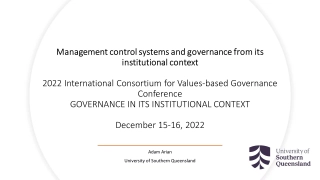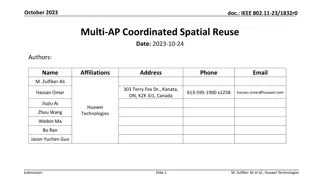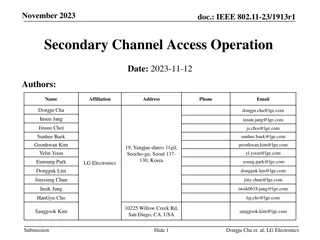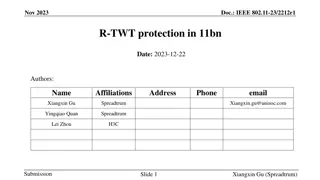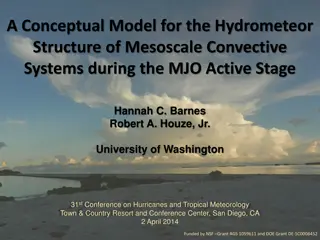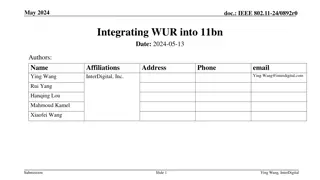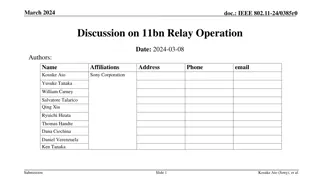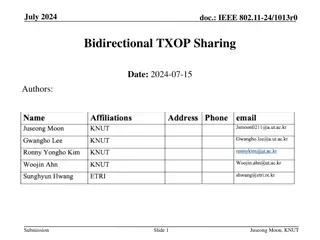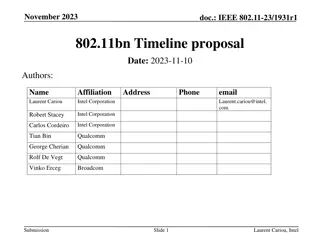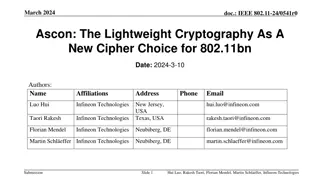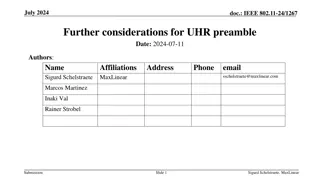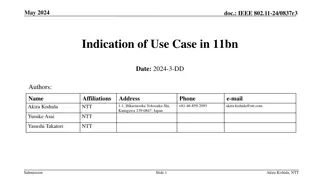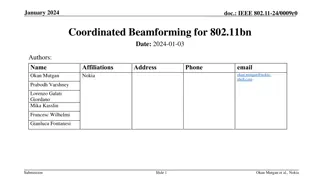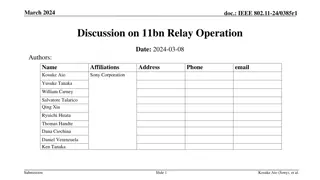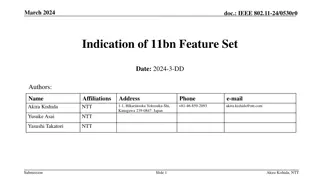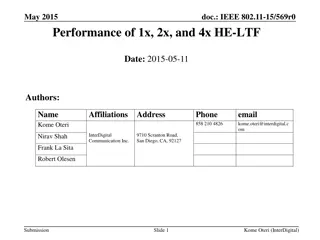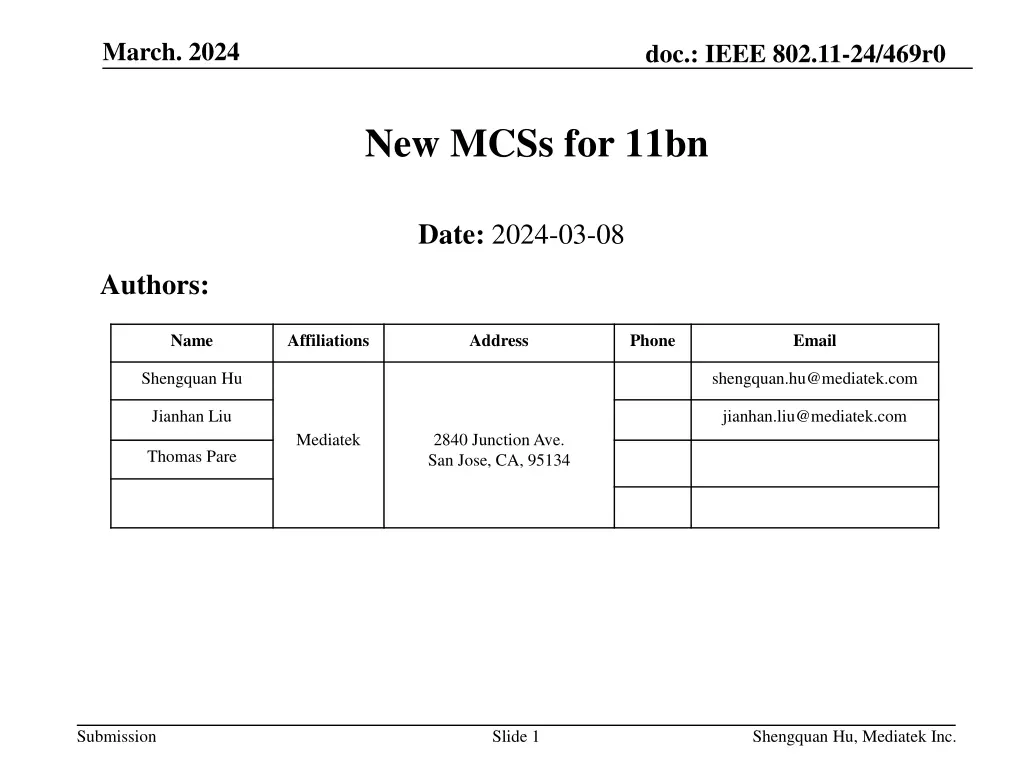
New MCSs for Enhanced Wi-Fi Generation
Explore the proposal for new MCSs in the upcoming Wi-Fi 8 generation to enhance throughput, reliability, and link adaptation. The idea is to utilize currently unused modulation and code rate combinations for improved performance and accuracy in unequal modulation scenarios. The gaps between existing MCS levels in the current Wi-Fi 7/11be generation are highlighted, suggesting room for improvement in achieving higher spectral efficiency and sensitivity SNR requirements.
Uploaded on | 0 Views
Download Presentation

Please find below an Image/Link to download the presentation.
The content on the website is provided AS IS for your information and personal use only. It may not be sold, licensed, or shared on other websites without obtaining consent from the author. If you encounter any issues during the download, it is possible that the publisher has removed the file from their server.
You are allowed to download the files provided on this website for personal or commercial use, subject to the condition that they are used lawfully. All files are the property of their respective owners.
The content on the website is provided AS IS for your information and personal use only. It may not be sold, licensed, or shared on other websites without obtaining consent from the author.
E N D
Presentation Transcript
March. 2024 doc.: IEEE 802.11-24/469r0 New MCSs for 11bn Date: 2024-03-08 Authors: Name Affiliations Address Phone Email Shengquan Hu shengquan.hu@mediatek.com Jianhan Liu jianhan.liu@mediatek.com Mediatek 2840 Junction Ave. San Jose, CA, 95134 Thomas Pare Submission Slide 1 Shengquan Hu, Mediatek Inc.
March 2024 doc.: IEEE 802.11-24/469r0 Introduction There are total 16 MCS levels (MCS0~15) in current generation Wi-Fi7/11be. The sensitivity SNR requirement (e.g. at 10% PER) gaps between some neighbor MCSs is quite large, e.g. > 3.5dB between MCS-2 & 3, and > 4dB between MCS-4 & 5 under AWGN, etc. Furthermore, current generation Wi-Fi 7 only uses half of all possible combinations of modulation and code rate Code rate R=2/3 is only used for MCS5 so far, it is impossible for 2/3 code rate to be used for unequal modulation (UEQM) New MCSs could be considered in next generation Wi-Fi 8 by using some of the non- used possible modulation and code rate combinations to achieve higher throughput, better reliability, better UEQM performance and more accurate link adaptation Submission Slide 2 Shengquan Hu, Mediatek Inc.
doc.: IEEE 802.11-24/469r0 MCSs in 11be 4 code rates 1/2 2/3 3/4 5/6 BPSK+DCM+DUP MCS14 BPSK+DCM MCS15 BPSK MCS0 QPSK MCS1 MCS2 7 modulations 16QAM MCS3 MCS4 64QAM MCS5 MCS6 MCS7 256QAM MCS8 MCS9 1024QAM MCS10 MCS11 4096QAM MCS12 MCS13 Total 14 combinations are not used yet Submission Slide 3 Shengquan Hu, Mediatek Inc.
doc.: IEEE 802.11-24/469r0 Spectral Efficiency for All MCS Levels in 11be The gap between two adjacent MCSs is about 1bit for some cases. Spectral Efficiency of 802.11be Modulation and Coding Schemes 11 10 Spectral Efficiency (Data Bits/Subcarrier) 10 9 9 8.33 7.5 8 6.67 7 6 6 Example: Spectral efficiency gap between adjacent MCS level = 1bit/Tone 5 4.5 5 4 4 3 3 2 1.5 2 1 0.5 1 0.25 0.125 0 -2 -1 0 1 2 3 4 5 6 7 8 9 10 11 12 13 MCS0 MCS13 MCS14 MCS15 MCS Level Submission Slide 4 Shengquan Hu, Mediatek Inc.
doc.: IEEE 802.11-24/469r0 Sensitivity SNR Requirements for Different MCSs on BW20 The sensitivity SNR requirement gap between two adjacent MCS levels can be 3~4 dB for some cases; The finer MCSs can enable more accurate rate adaptation and better unequal QAM performance. SNR gap > 3.5dB SNR gap > 3.5dB SNR gap > 4dB Sensitivity SNR (dB) at 10% PER Submission Slide 5 Shengquan Hu, Mediatek Inc.
doc.: IEEE 802.11-24/469r0 Sensitivity SNR Requirements for Different MCSs on BW80 The sensitivity SNR requirement gap between two adjacent MCS levels can be 3~4 dB for some cases; The finer MCSs can enable more accurate rate adaptation and better unequal QAM performance. SNR gap > 3.5dB SNR gap > 3.5dB SNR gap > 4dB Sensitivity SNR (dB) at 10% PER Submission Slide 6 Shengquan Hu, Mediatek Inc.
doc.: IEEE 802.11-24/469r0 Considerations to Add New MCSs for 11bn From above studies & analysis, we observe that: o The sensitivity SNR gap between some adjacent MCS levels is quite large (e.g. >3 or 4dB) o There are also spectral efficiency gaps between some adjacent MCS levels o The existing MCS definition only utilizes a few of combinations of modulation and coding rate Therefore, we propose adding new MCSs by using existing modulation and coding rate combination to o fill up the sensitivity SNR gap o improve the link adaptation accuracy o increase throughput o enhance UEQM performance Submission Slide 7 Shengquan Hu, Mediatek Inc.
doc.: IEEE 802.11-24/469r0 Existing MCSs and New MCSs Candidates in Study QAM/R 1/2 2/3 3/4 5/6 BPSK QPSK 16QAM 64QAM 256QAM 1024QAM 14 combinations for new MCS candidates 4096QAM 14 existing MCSs Spectral Efficiency (bits/tone) Spectral Efficiency (bits/tone) 0.67 0.75 0.83 1.33 1.67 2.67 3.00 3.33 4.00 5.00 5.33 6.00 6.67 8.00 existing MCS index (11be) QAM Nbpscs R QAM Nbpscs R BPSK BPSK BPSK QPSK QPSK 16QAM 64QAM 16QAM 256QAM 1024QAM 256QAM 4096QAM 1024QAM 4096QAM 1 1 1 2 2 4 6 4 8 2/3 3/4 5/6 2/3 5/6 2/3 1/2 5/6 1/2 1/2 2/3 1/2 2/3 2/3 0 1 2 3 4 5 6 7 8 9 BPSK QPSK QPSK 16QAM 16QAM 64QAM 64QAM 64QAM 256QAM 256QAM 1024QAM 1024QAM 4096QAM 4096QAM 1 2 2 4 4 6 6 6 8 8 1/2 1/2 3/4 1/2 3/4 2/3 3/4 5/6 3/4 5/6 3/4 5/6 3/4 5/6 0.500 1.000 1.500 2.000 3.000 4.000 4.500 5.000 6.000 6.667 7.500 8.333 9.000 10.000 10 8 12 10 12 10 11 12 13 10 10 12 12 Submission Slide 8 Shengquan Hu, Mediatek Inc.
doc.: IEEE 802.11-24/469r0 Simulation Setup BW: 20MHz, 80MHz, 160MHz Channel: AWGN, D-NLOS, B-LOS, E-NLOS 1ss: 1T1R, 1T2R, 1T4R, 2T1R (BF), 4T1R (BF) 2ss: 2T2R (non-BF) 3ss: 3T3R (non-BF) 4ss: 4T4R (non-BF) Channel Estimation (CE): Least-Square (LS) CE, and CE with smoothing (SMCE) Packet length: 1458bytes, 2048bytes, 4096bytes, scaled packet length for each MCS to make Nsym=10 Receiver for MIMO: MLD (for 2ss), ML-type Rx (for 3ss/4ss), MMSE LDPC MCS levels: Existing 11be MCSs: 0~13 14 New MCS candidates Goodput Calculation: Assume 3.2us GI Goodput ???? = max{ 1 ??? 12.8+?? PktLen (Bytes) QAM Nbpscs R Nsym BPSK 1 1/2 10 560 QPSK 2 1/2 10 1120 QPSK 2 3/4 10 1680 16QAM 4 1/2 10 2240 16QAM 4 3/4 10 3360 64QAM 6 2/3 10 4480 64QAM 6 3/4 10 5040 64QAM 6 5/6 10 5600 ?????? ??? ? 256QAM 8 3/4 10 6720 *???} 256QAM 8 5/6 10 7467 1024QAM 10 3/4 10 8400 1024QAM 10 5/6 10 9333 4096QAM 12 3/4 10 10080 4096QAM 12 5/6 10 11200 BPSK 1 2/3 10 747 QPSK 2 2/3 10 1493 Note: packet length in the table is for Nss=1; for Nss>=2, the packet length will be PktLen*Nss to make Nsym=10 ; 16QAM 4 2/3 10 2987 16QAM 4 5/6 10 3733 256QAM 8 2/3 10 5973 Submission Slide 9 Shengquan Hu, Mediatek Inc.
doc.: IEEE 802.11-24/469r0 BW80, D-NLOS, 2x2x2, non-BF, SMCE, Scaled Packet Length, ML-Type Rx Three figures in this page show the Goodput, the MCS index, and Gput gains of {new MCS+existing MCS} vs {existing MCS} The new MCS candidates are only selected with the criteria of the Gput gains >= 5% New MCS candidates {QPSK+R23,16QAM+R23,16QAM+R56,256QAM+R23} improve the data rate >=5% 256QAM R23 16QAM R56 16QAM R23 QPSK R23 This MCS candidate is not selected due to small SNR region span 256QAM R23 16QAM R56 16QAM R23 QPSK R23 Gput gain >= 5% Submission Slide 10 Shengquan Hu, Mediatek Inc.
doc.: IEEE 802.11-24/469r0 BW80, D-NLOS, 2x2x2, non-BF, SMCE, Scaled Packet Length, ML-Type Rx The PER curves for the selected extra MCSs are plotted together with the existing MCSs as below Selected new MCSs can fill up the sensitivity SNR gap & improve the data rate The following figure shows that, by using ML-Type receiver: o New MCS with {QPSK, 2/3} may be added between existing MCS-1 & 2 o New MCS with {16QAM, 2/3} may be added between existing MCS-3 & 4 o New MCS with {16QAM, 5/6} may be added between existing MCS-4 & 5 o New MCS with {256QAM, 2/3} may be added between existing MCS-7 & 8 256QAM +R2/3 16QAM +R5/6 QPSK +R2/3 16QAM +R2/3 Submission Slide 11 Shengquan Hu, Mediatek Inc.
doc.: IEEE 802.11-24/469r0 Spectral Efficiency after Adding New MCSs Adding the selected new MCSs can also fill up the efficiency gaps 256QAM +R2/3 16QAM +R5/6 16QAM +R2/3 QPSK +R2/3 Submission Slide 12 Shengquan Hu, Mediatek Inc.
doc.: IEEE 802.11-24/469r0 Summary of Simulations and Observations New MCS candidates to achieve Gput gain (>= 5%) {C1,C2,C3,C4} {C1,C2,C3,C4} {C1,C2,C3,C4} {C1,C2,C3,C4} {C1,C2,C3,C4} {C1,C2,C4} {C1,C2,C4} {C1,C2,C4} {C1,C2,C4} {C1,C2} {C1,C2,C4} {C1,C2} {C1,C2} {C1,C2} {C1,C2,C3,C4} {C1,C2,C3,C4} {C1,C2} {C1,C2,C3,C4} {C1,C2} {C1,C2} {C1,C2,C3,C4} {C1,C2,C3} {C1,C2,C3} {C1,C2,C3} {C1,C2,C3,C4} {C1,C2,C3} {C1,C2,C3} {C1,C2,C3,c4} {C1,C2,C3,C4} {C1,C2,C3} {C1,C2,C3} {C1,C2,C4} {C1,C2,C3} {C1,C2,C3} {C1,C2,C3} {C1,C2,C3,c4} {C1,C3} {C1,C2,C3} {C1,C2,C3,C4} {C1,C2,C4} {C1,C2,C3,C4} {C1,C2,C4} {C1,C2,C3,C4} {C1,C2,C3} {C1,C2,C3} {C1,C2,C3} {C1,C2,C3} Nss Config BF Channel CE PktLen (Bytes) BW (MHz) NOTE: C1 for QPSK+R2/3 C2 for 16QAM+R2/3 C3 for 16QAM+R5/6 C4 for 256QAM+R2/3 AWGN AWGN AWGN AWGN AWGN D-NLOS D-NLOS D-NLOS E-NLOS B-LOS D-NLOS B-LOS B-LOS D-NLOS D-NLOS D-NLOS B-LOS D-NLOS B-LOS B-LOS D-NLOS D-NLOS B-LOS E-NLOS D-NLOS D-NLOS B-LOS E-NLOS D-NLOS D-NLOS D-NLOS D-NLOS D-NLOS B-LOS D-NLOS D-NLOS B-LOS B-LOS D-NLOS D-NLOS D-NLOS B-LOS B-LOS D-NLOS B-LOS D-NLOS B-LOS LS LS SM LS SM LS LS 1458 1458 1458 scaled scaled 1458 1458 20 80 80 80 80 20 80 1T1R N SM 1458 80 LS SM SM SM SM SM SM SM SM SM SM scaled 2048 4096 4096 2048 4096 4096 4096 2048 4096 2048 80 20 20 20 80 80 80 160 160 160 80 The behavior of combinations of QAM & Code rate is different not only for AWGN vs multipath fading channels but also for: o Tx & Rx antenna config o Type of MIMO detector o etc For most of practical scenarios & settings, the proposed four new MCS candidates can fill the SNR gap and improve the system throughput by 5%~30% 1 1T2R N 1T4R N LS 1458 80 2T1R LS 4096 80 Y LS 1458 80 4T1R LS SM LS LS SM SM 4096 1458 1458 4096 4096 4096 1458 4096 1458 4096 4096 scaled scaled scaled scaled 4096 4096 4096 4096 80 80 80 80 20 20 2T2R 2T2R 2T2R 2T2R 2T2R N 2T2R SM 80 2 N 2T2R 2T2R 2T2R 2T2R 2T2R 2T2R 3T3R 3T3R 4T4R 4T4R SM SM LS SM LS SM SM SM SM SM 160 160 80 80 80 80 80 80 80 80 3 N 4 Submission Slide 13 Shengquan Hu, Mediatek Inc.
doc.: IEEE 802.11-24/469r0 Summary of Simulations There are total 47 cases considered in the simulations The following table summarizes the number of times (or occurrence count) for a new MCS is selected over 47 cases with the MCS selection criteria of Tput gain >= 5% New MCS Count of Selected % of selected (QPSK+R2/3) 47 100.00 (16QAM+R2/3) 46 97.87 (16QAM+R5/6) (256QAM+R2/3) 32 68.09 24 51.06 256QAM +R2/3 QPSK +R2/3 16QAM +R2/3 16QAM +R5/6 Submission Slide 14 Shengquan Hu, Mediatek Inc.
Dec. 2022 doc.: IEEE 802.11-24/469r0 Summary We studied the performance and spectral efficiency of current MCSs in 11be. There are 3-4dBs SNR gap between some adjacent MCSs. There are about 1bit spectral efficiency gap between some adjacent MCSs. We propose to adding new MCSs to fill the sensitivity SNR requirement gap between adjacent MCSs to achieve higher throughput, better reliability, more accurate link adaptation Our simulations and analysis show that The finer MCSs can improve the throughput by 5%~30% for most of the scenarios The combinations of {QPSK, 16QAM, 256QAM} + R=2/3 and 16QAM+R=5/6 could be considered as the new MCSs for 11bn The new MCSs can be considered as the fundamental base for both EQM and UEQM Submission Slide 15 Shengquan Hu, Mediatek Inc.
doc.: IEEE 802.11-24/469r0 Straw Poll #1 Do you agree to include the following text to the 11bn SFD? adding new MCS level(s) for 11bn Submission Slide 16 Shengquan Hu, Mediatek Inc.
doc.: IEEE 802.11-24/469r0 Straw Poll #2 Do you agree to include the following text to the 11bn SFD? adding the following modulation and code rate combinations as the new MCSs for 11bn? Modulations of {QPSK, 16QAM, 256QAM} with code rate R=2/3 Modulation of 16QAM with code rate R=5/6 Submission Slide 17 Shengquan Hu, Mediatek Inc.

